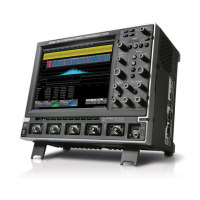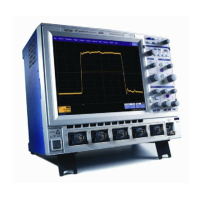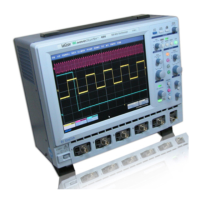230 WM-OM-E Rev I
Performance
Under optimal conditions, on a scope with a 1.7 GHz Celeron processor, rates of up to 75 MS/s
have been observed. Due to the differences between the acquisition and processing hardware in
each of the X-Stream scopes, this value may vary significantly and therefore cannot be guaranteed.
However, this is by far the fastest way to process data using a user-defined algorithm on an
X-Stream scope.
Choice of Programming Language
The system was designed for use with the C/C++ programming language, and all furnished
examples use this language. It is theoretically possible, however, for the processing to be
implemented in any language that supports Windows named events (Mutex) and can open a
named memory-mapped file. Nevertheless, no guarantee can be given as to the behavior of the
system using anything but C/C++.
FFT
Why Use FFT?
For a large class of signals, you can gain greater insight by looking at spectral representation rather
than time description. Signals encountered in the frequency response of amplifiers, oscillator phase
noise and those in mechanical vibration analysis, for example, are easier to observe in the
frequency domain.
If sampling is done at a rate fast enough to faithfully approximate the original waveform (usually five
times the highest frequency component in the signal), the resulting discrete data series will
uniquely describe the analog signal. This is of particular value when dealing with transient signals
because, unlike FFT, conventional swept spectrum analyzers cannot handle them.
Spectral analysis theory assumes that the signal for transformation is of infinite duration. Since no
physical signal can meet this condition, a useful assumption for reconciling theory and practice is to
view the signal as consisting of an infinite series of replicas of itself. These replicas are multiplied by
a rectangular window (the display grid) that is zero outside of the observation grid.
An FFT operation on an N-point time domain signal can be compared to passing the signal through
a comb filter consisting of a bank of N/2 filters. All the filters have the same shape and width and are
centered at N/2 discrete frequencies. Each filter collects the signal energy that falls into the
immediate neighborhood of its center frequency. Thus it can be said that there are N/2 frequency
bins. The distance in Hz between the center frequencies of two neighboring bins is always the
same: Delta f.
Power (Density) Spectrum
Because of the linear scale used to show magnitudes, lower amplitude components are often
hidden by larger components. In addition to the functions offering magnitude and phase
representations, the FFT option offers power density and power spectrum density functions. These
latter functions are even better suited for characterizing spectra. The power spectrum (V
2
) is the
square of the magnitude spectrum (0 dBm corresponds to voltage equivalent to 1 mW into 50
ohms.) This is the representation of choice for signals containing isolated peaks --- periodic signals,
for instance.
The power density spectrum (V
2
/Hz) is the power spectrum divided by the equivalent noise
